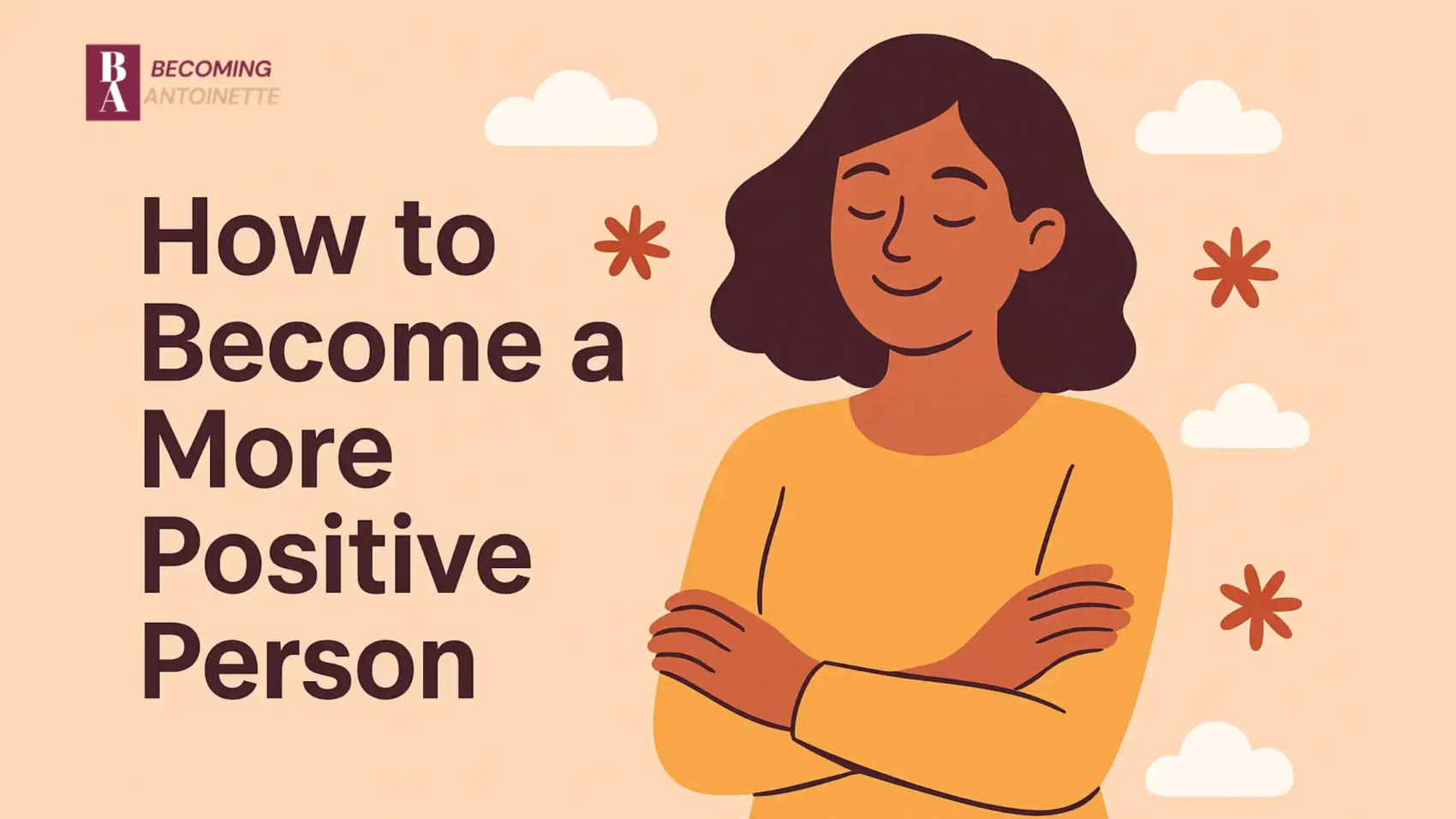Are you worn out from always feeling like negativity drags you down? I’m right there with you—it used to feel like I lived my life beneath a heavy storm cloud, wishing I could just break free and finally breathe. Figuring out how to become a more positive person honestly felt out of reach during those dark days. But, through countless small decisions and lots of trial and error, I found a way forward that I’m so grateful for now.
These aren’t just “some expert’s tips,” either—I’ve lived every struggle and setback I talk about. I’m passionate about coaching other women because I remember what it was like to feel alone. So if you’re quietly wondering, “how do I become a positive person?” or just desperate to know how to have positive thoughts—please know you’re not alone. I’ve been where you are, and change is absolutely possible. Let’s walk through it together.
What Being a Positive Person Really Means (from Someone Who Learned the Hard Way)
I used to believe that being “positive” was all about pretending everything was fine, burying my pain, and forcing a smile. As you can probably guess, that only made things harder. In truth, learning how to become a more positive person meant shifting my perspective and owning my feelings—even on the tough days. A genuine positive mindset is about giving yourself grace, searching for gratitude, and refusing to let fear or doubt have the last word.
How Mindset Changes Everything
I wish I’d known sooner how much my mindset colored every part of my life. At my lowest, I saw challenges as evidence I wasn’t good enough. But with small mindset shifts, I started seeing obstacles as opportunities. That’s the first step I guide my clients through: noticing how their beliefs shape their world. If you need a place to dig deeper, I can’t recommend enough reading about how to change your mindset. That resource was a game changer for me and for so many of the women I support.
5 True-to-Life Lessons That Helped Me Become More Positive
1. Listening to—and Confronting—My Negative Self-Talk
My own inner dialogue used to be mean, honestly. I’d put myself down and find fault with just about everything I did. It wasn’t until I started really listening that I caught myself in old patterns. Instead of letting “I’ll never get this right” run unchecked, I started saying, “I’m learning, and that’s enough.” Have you ever caught yourself in a negative spiral? Try asking, “Is this helping me?” It’s such a simple question, but it might just change your day.
Here’s the practice that made all the difference for me:
| Negative Thought | Reframed Positive Thought |
| “I can’t do this.” | “This is hard, but I can try.” |
| “I always fail.” | “Failures teach me lessons.” |
| “I’m not enough.” | “I am growing every day.” |
I filled journals with tables like this until it became second nature. I wasn’t surprised to learn that the National Institutes of Health has found positive self-talk to be a powerful tool for emotional well-being.
2. Curating My Circle—With Love and Boundaries
I wish someone told me earlier that you become who you surround yourself with. When my day-to-day was filled with complainers or constant negativity, staying positive felt impossible. Step by step, I made room for people who uplifted, listened, or just brought out the best in me. It isn’t easy to set boundaries, especially with people you care about, but it’s absolutely essential for a positive mindset.
If you’re worried about feeling isolated, trust me—community is out there. I’ve found encouraging people in family, book clubs, online groups, and even at the park! Don’t be afraid to seek out spaces that support your growth.
3. Creating a Nightly Gratitude Ritual
When things felt most hopeless, I started writing down three things I was grateful for before bed. Sometimes it was big, but often it was just “a hot shower” or “getting through the day.” Over time, this practice rewired my focus from lack to abundance. There’s actual science to support this—Harvard Medical School shares how a regular gratitude practice can boost happiness and create more positive thoughts.
If you’re new to this, start tiny: keep a scrap of paper or a note on your phone. Add a date and jot down one thing that went right—even if it’s just “I smiled today.”
Coach’s Note: Review your gratitude notes weekly. You’ll be amazed at how your mindset gently shifts.
4. Tackling Negativity One Small Step at a Time
One thing I hear from so many women is, “How do I stop being negative all the time?” The truth? There is no magic switch. What worked for me was paying attention to my triggers. For example, certain social media posts would leave me feeling down, so I started limiting how often I checked them.
Next, I practiced actively swapping negative comments for something neutral or positive. Instead of complaining about rain, I’d say, “It’s cozy inside.” And the more I celebrated these small victories—however tiny—the easier everything got.
5. Nourishing My Mind with What Inspires Me
I discovered that what I fed my mind mattered more than I realized. I swapped scrolling through bad news for uplifting podcasts, short walks listening to motivational talks, or simply watching shows that made me laugh. Gradually, these positive choices became my new habits. Even today, if I find myself stuck, I ask: “What can I listen to or read that will lift me up right now?” That simple shift helps me have positive thoughts and stay resilient, especially when old patterns want to creep in.
How to Remain Positive When Life Is Wild (Because Real Life Isn’t Predictable)
Let’s be honest—there are days when simply getting out of bed feels like a victory. On my hardest days (the ones I used to hide from everyone), here are the things that kept me afloat:
- Pause and breathe: I count to three, breathe in, and let myself settle. Sometimes, that moment of quiet resets my whole perspective.
- Choose my focus: Instead of stressing about everything going wrong, I try to find one thing I can influence and put my energy there—even if it’s just making my bed.
- Remember my why: I write out why I want a positive mindset—to be a strong example for my kids, to live with more peace, to honor my journey. Reconnecting with that “why” anchors me in tough moments.
How Visualization Anchored My Journey
On the roughest nights, I used a trick I highly recommend. I’d close my eyes and picture the me I wished I could be—lighter, smiling, feeling good inside. That mental image became a real goal I could move toward. Visualization works as a bridge between where you are and where you want to go, and over time, it pulled me closer to the woman I always wanted to become.
Real Questions from Real Women (Just Like You)
I’ve been humbled to coach women through these same struggles, and these are questions I hear all the time:
How do I become a positive person when my world is negative?
Start with what you can control: your words, your habits, and your own mindset. Bit by bit, you’ll notice the shift—and sometimes, your outlook inspires those around you, too.
What truly helps me stop being negative, practically?
Choose just one habit that holds you back (like endless news scrolling) and swap it for something gentler, like reading an inspiring article or a daily affirmation. The first steps are always the hardest, but you’ve got this.
Does being positive mean I should ignore my problems?
Absolutely not. I remind my clients that real positivity means seeing the tough stuff clearly, but choosing hope anyway. You don’t have to pretend everything is perfect—honest optimism is about facing reality and still believing things can get better.
Is gratitude just a feel-good fad?
No way! In fact, gratitude is supported by scientific research. Even adding one act of thankfulness a day can slowly train your brain for contentment and joy.
What if I mess up and feel negative again?
First, be kind to yourself. There’s no linear journey here. If you slip up, take a breath, figure out what set you back, and remember: every day is a fresh chance.
The Bottom Line—From My Heart to Yours
Learning how to become a more positive person isn’t about pretending or perfection. It’s about consistently choosing yourself, honoring even your smallest progress, and reaching for the resources that support your growth. I promise, every effort matters. Don’t hesitate to visit how to change your mindset when you need encouragement or a new starting point.
If I can find the light again, you can too. And though it isn’t easy—oh, it is so worth it. Let’s keep moving forward together.


Leave Your Comment